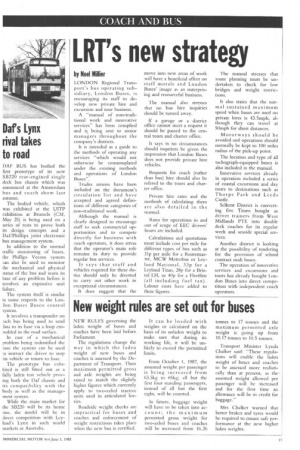LRT's new strategy
Page 19

If you've noticed an error in this article please click here to report it so we can fix it.
by Noel Millier
LONDON Regional Transport's bus operating subsidiary, London Buses, is encouraging its staff to develop new private hire and excursion and tour business.
A "manual of non-traditional work and innovative services" has been complied and is, being sent to senior managers throughout the company's districts.
It is intended as a guide to the methods of operating any services "which would not otherwise be comtemplated under the existing methods and operations of London Buses".
Trades unions have been included on the document's circulation list and have accepted and agreed definitions of different categories of ,non-traditional work.
Although the manual is clearly designed to encourage staff to seek commercial opportunities and to compete directly for business with coach operators, it does stress that the operator's main role remains its duty to provide regular bus services.
It says that staff and vehicles required for these duties should only be diverted to carry out other work in exceptional circumstances.
It does suggest that the move into new areas of work will have a beneficial effect on staff morale and London Buses' image as an enterprising and resourceful business.
The manual also stresses that no bus hire inquiries should be turned away.
If a garage or a district office cannot meet a request it should be passed to the central tours and charter office.
It says in no circumstances should inquirers be given the impression that London Buses does not provide private hire vehicles.
Requests for coach (rather than bus) hire should also be refered to the tours and charter office.
Private hire rates and the methods of calculating them are also detailed in the manual.
Rates for operations in and Out of scope of EEC drivers' hours are included.
Calculations and quotations must include cost per mile for different types of bus such as 31p per mile for a Routemaster, MCW Metrobus or Leyland National, 33p for a Leyland Titan, 28p for a Bristol LH, or 40p for a Fleetline (all including fuel tax). Labour costs have added to these figures. The manual stresses that route planning must be undertaken to check for low bridges and weight restrictions.
It also states that the normal sustained maximum speed when buses are used on private hires is 43.5mph, although they can travel at 50mph for short distances.
Motorways should be avoided and operations should normally be kept to 100 miles radius of the pick-up point.
The location and type of all tachograph-equipped buses is also included in the manual.
Innovative services already in operation included a series of coastal excursions and day tours to destinations such as Thorpe Park and Leeds Castle.
Selkent District is converting five Titans bought as driver trainers from West Midlands PTE into double deck coaches for its regular week and seaside special services.
Another district is looking at the possibility of tendering for the provision of school contract midi buses.
The operation of innovative services and excursions and tours has already bought London Buses into direct competition with independent coach operators.




















































































